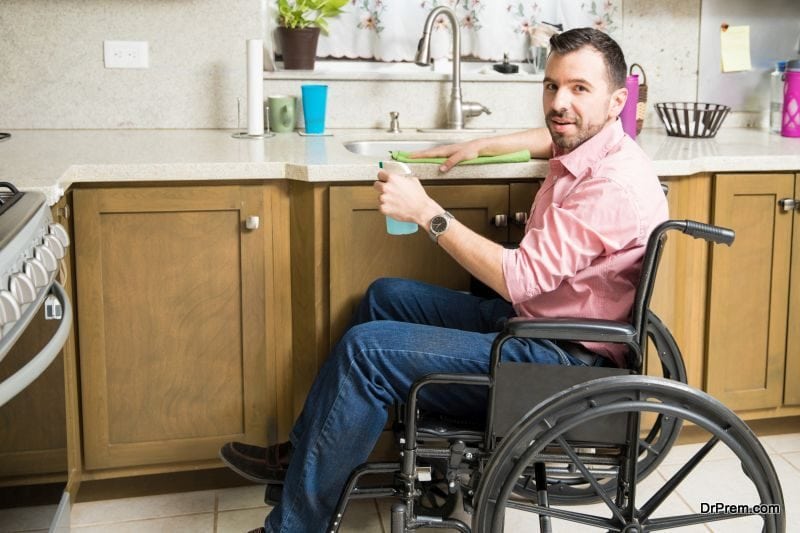If you or a loved one are permanently or temporarily handicapped, the inability to move around freely greatly impacts your entire life. You may need to make several adjustments to your lifestyle in order to accommodate your needs. With over 56 million Americans suffering from some sort of physical disability, adjustments and accommodations are more commonplace than ever before. Here are several tips for making your home and other aspects of your life handicap accessible.
Build Ramps

One of the most common ways to make a home more handicap accessible is to install ramps where needed. Wheelchair ramps are most beneficial when installed outside the home. This allows individuals to easily enter and exit their home without the use of steps. But ramps are not only for those in wheelchairs. Anyone suffering from decreased mobility can benefit from the use of ramps. Often times, anyone using a cane, walker or crutches will have difficulty navigating steps. Whether it is due to a chronic or acute injury or overall body fatigue and weakness, ramps are much easier and safer to use than steps. Some areas require a permit when building a ramp onto a home, so it’s important to check with your local government before making any changes to your home’s structure.
Use Railings
In addition to a ramp, the use of railings is especially helpful for those suffering from a handicap that impairs mobility and makes it difficult to balance or move around. There’s no limitation to where you can install handrails in and around your home. All stairs and/or ramps should have sturdy and secure railings that allow occupants to lean on them without fear of falling. Railings also come in handy in other parts of the home, including the kitchen and bathroom. Railings in the showers are especially helpful due to the risk of a handicapped individual slipping and falling. The wet floor of both the shower and bathroom itself are a hazard for slips and falls. Railings offer assistance and support in all areas of the home.
Widen Doorways

For those individuals using either a wheelchair or walker, sometimes doorways are simply too narrow for easy passage. In this case, widening the doorways in your home will make it much easier for occupants to maneuver and navigate freely. Depending on how many doorways need widening, this can be a costly project. Another alternative is to simply replace the hinges on doors, allowing them to open completely and clear the entire opening. This will afford you a few extra inches for both wheelchairs and walkers to pass through.
Renovate your Bathroom
Handrails in the shower aren’t the only way to make your bathroom more handicap accessible. Adding railings near the toilet is another way to prevent falls and ensure that anyone using the toilet is able to get up and down without injuring themselves. Adding a toilet riser is another common addition for handicap accessible homes. A riser eliminates the need for users to lower themselves so far down onto the toilet. This helps protect the person’s back and prevent strain or overexertion, which can lead to shortness of breath and other complications.
Adding a seat to the shower will allow handicapped individuals to sit while cleaning themselves. Often times, it’s difficult for elderly or handicapped individuals to stand steady and balanced for extended periods of time. Because the shower is already slippery and poses a potential hazard, having a bench or seat available ensures their safety and allows for a comfortable, risk free shower. Showers with little to no edge are easiest for those with handicaps to step into. Tubs with high sides or showers with large lips are difficult to navigate and put people at risk of tripping and falling.
Redo Your Kitchen

Most people spend a lot of time in their kitchens, so this is another room in your house that will need renovating to make it more handicap accessible. Lowering cabinets will allow anyone in a wheelchair to perform daily tasks like cooking, doing dishes, and making coffee. When possible, position appliances near one another so occupants don’t have to travel too far to accomplish tasks. Most dishwashers are already low to the ground and perfect for wheelchair users. Keep supplies and food items on the lower shelves of pantries and cabinets. If someone with a handicap attempts to pull items from a high shelf, they are at risk for injury if the items fall onto their head or body.
Hardwood vs. Carpet
Not only are hardwood floors beautiful, but they’re also much more user-friendly for handicapped individuals. Whether they are using a wheelchair, walker, cane, or crutches – all of these items move better on a hard, clean surface versus a plush carpet. Rolling a wheelchair across the carpet would be extremely difficult for anyone pushing it and nearly impossible for the individual in the chair to do on their own. Trying to navigate crutches, a cane, or a walker on carpet would also prove difficult. Moving around should be relatively effortless for those suffering from a handicap. Make life easier for everyone by investing in hardwood or linoleum floors.
Just be sure to keep the floors clean and free of any spills or liquids which create a fall hazard. Area rugs can also create a danger, especially when someone is using a cane, walker, or crutches to move around. If any of these items get caught on a rug, the person can easily fall and incur additional injuries. Removing all rugs from your home will ensure handicap occupants remain safe.
Consider your Vehicle

Your home isn’t the only place that may need adjusting to accommodate handicapped individuals. There are several ways to make your vehicle handicapped accessible as well. For those in wheelchairs, the most common addition to any vehicle is a wheelchair lift. These are installed in larger vehicles, including minivans. Most wheelchair lifts consist of a hydraulic ramp that lowers, allowing the wheelchair to be rolled in place, before lifting and safely returning inside the vehicle.
For someone suffering from an injury, obesity or immobility of any kind, investing in a vehicle that has seats at a moderate height is best. Small cars with low seats are difficult for handicapped individuals to enter and exit. The same holds true for high seats found in many pickup trucks. Pulling yourself up into a jacked up, high truck takes quite a bit of effort and may be dangerous for those who are injured, handicapped, or uncoordinated due to an existing condition.
Install a Dumbwaiter
Carrying groceries or other bags into the house can be a chore for anyone, but this is especially true for someone suffering from a handicap. In order to safely and efficiently bring items into your home, invest in a dumbwaiter. Dumbwaiters are small elevators installed in homes that allow you to move items from the first to the second floor without carrying them. If you’re able to, install the dumbwaiter close to your garage or driveway. This way, you can easily place the items on the elevator without traveling too far.
Choose and Place Furniture Properly

This tip goes hand in hand with widening doorways in your home. The placement of furniture can make navigating through your home easier or harder for anyone with a handicap or impairment. Try widening pathways between pieces of furniture to create ample room for passing by. Invest in sturdy furniture that isn’t flimsy. This allows for occupants to lean on and comfortably sit without fear of falling or injury. For those furniture pieces that are low to the ground, you can use furniture coasters or small blocks of wood to raise these items up.
Ask for Help
Don’t let pride get in the way when it comes to creating a safe, handicap accessible home and life. Asking for help from family and friends is one of the smartest things you’ll ever do. Whether you were born with a handicap, are simply recovering from an injury, or your medical status has recently changed, you must accept your current situation.
Trying to continue living life the way you used to without accommodating your new limitations could result in further injury and prolonged recovery. If someone is willing to assist you, let them. Help can come in many forms from someone who’s willing to drive you to and from your doctor appointments to a handy friend who offers to install handrails for you and widen your doorways. Try not to see your handicap as a negative thing, but instead as an adjustment to your life.
If you’re having difficulty adjusting to this new lifestyle that requires you to change your entire home and lifestyle, you may need to speak with a therapist, life coach or other medical professional who can help you cope with these changes.
Article Submitted By Community Writer




